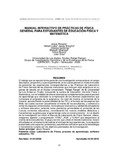| dc.rights.license | http://creativecommons.org/licenses/by-nc-sa/3.0/ve/ | |
| dc.contributor.author | Rosario, Jesús | |
| dc.contributor.author | Lobo, Hebert | |
| dc.contributor.author | Briceño B., Jesús R. | |
| dc.contributor.author | Gutiérrez, Gladys | |
| dc.contributor.author | Villarreal, Manuel | |
| dc.contributor.author | Rivero, Dilue | |
| dc.contributor.author | Díaz, Juan Carlos | |
| dc.date.accessioned | 2010-11-10T19:19:47Z | |
| dc.date.available | 2010-11-10T19:19:47Z | |
| dc.date.issued | 2010-06-30 | |
| dc.identifier.issn | 1690-3226 | es_VE |
| dc.identifier.uri | http://www.saber.ula.ve/handle/123456789/31825 | |
| dc.description.abstract | El trabajo que se reporta forma parte de una investigación enmarcada en el campo
descriptivo, proyectivo y cuasi-experimental, en la cual se planteó un modo innovador
de presentar las experiencias correspondientes a las Prácticas de Laboratorio
de Física General de las diversas menciones que incluyen está asignatura en su
pensa de estudio en el Núcleo Universitario “Rafael Rangel” de la Universidad
de Los Andes en Trujillo, incluyendo la carrera de Educación, mención Física y
Matemática, con la fi nalidad de ofrecer alternativas complementarias para el proceso
de aprendizaje que estimulen la comprensión de los diversos experimentos que
contempla el programa de la asignatura. Se trató de mostrar el contenido de la
materia aprovechando la potencialidad de las TIC y el formato de las paginas tipo
Web, las cuales cautivan actualmente el interés de los estudiantes, y comienza a
tomar los espacios universitarios, motivados por el atractivo y calidad de simuladores
y software educativo; teniendo como elementos primordiales el contenido de las
nuevas corrientes educativas, considerando los nuevos modelos didácticos y
herramientas surgidos para el aprendizaje como el constructivismo. En el diseño
de la investigación se utilizó el Manual de Laboratorio de Física General, videos,
imágenes, appletsa y programación HTMLb, JAVAc y FLASHd que despertaron el
interés de los estudiantes. El grupo control, que utilizó el método tradicional, mostró
difi cultades en el momento de realizar el montaje de las experiencias. La evaluación
presentada a los expertos, profesores y estudiantes ratifi caron que esta metodología
o herramienta cumple con los objetivos planteados de la investigación.
Autor principal: Jesús Rosario | es_VE |
| dc.language.iso | es | es_VE |
| dc.publisher | SABER-ULA | es_VE |
| dc.rights | info:eu-repo/semantics/openAccess | |
| dc.subject | Laboratorio de Física | es_VE |
| dc.subject | Software educativo | es_VE |
| dc.subject | TIC | es_VE |
| dc.subject | Proceso de aprendizaje | es_VE |
| dc.title | Manual interactivo de prácticas de física general para estudiantes de educación física y matemática | es_VE |
| dc.title.alternative | Interactive manual of practices of general physics for students of physical education and mathematical | es_VE |
| dc.type | info:eu-repo/semantics/article | |
| dc.description.abstract1 | The work that reports form leaves from a descriptive, projective and cuasiexperimental
investigation, in which an innovating way considered to present/display
the experiences corresponding to the Practices of Laboratory of General physics
of the diverse mentions that they include is subject in his pensa of study in the
Núcleo Universitario Rafael Rangel of the Universidad de Los Andes in Trujillo,
including the race of Education, Physical and Mathematical mention, in order to offer
complementary alternatives for the learning process that stimulate the understanding
of the diverse experiments that contemplates the program of the subject. One was
to show to the content of the matter being useful the potentiality the TIC and the
format of the pages type Web, which at the moment captivate the interest of the
students, and begins to take the university spaces, motivated by attractive and the
quality of simulators and educative software; having like fundamental elements
the content of the new educative currents, considering the new models and tools
arisen for the learning like the constructivism. In the design of the investigation the
Manual of Laboratory of General Physics was used, videos, images, applet and
programming HTML, JAVA and FLASH that woke up the interest of the students.
The group control, that used the traditional method, showed diffi culties when to
make the assembly. The evaluation presented/displayed to the experts, professors
and students ratifi ed that this methodology or tool fulfi lls the raised objectives of
the investigation. Main author: Jesus Rosario | es_VE |
| dc.description.colacion | 30-48 | es_VE |
| dc.description.email | jrosario@ula.ve | es_VE |
| dc.description.email | hlobo@ula.ve | es_VE |
| dc.description.email | jesusb@ula.ve | es_VE |
| dc.description.email | gladysg@ula.ve | es_VE |
| dc.description.email | mavu@ula.ve | es_VE |
| dc.description.email | dilue@ula.ve | es_VE |
| dc.description.email | juand@ula.ve, jcdaz@hotmail.com | es_VE |
| dc.publisher.pais | Venezuela | es_VE |
| dc.subject.dependencia | Servicios Bibliotecarios de la Universidad de Los Andes (SERBIULA) | es_VE |
| dc.subject.facultad | Núcleo Rafael Rangel (NURR) | es_VE |
| dc.subject.keywords | Interactive physic | es_VE |
| dc.subject.keywords | Physics Laboratory | es_VE |
| dc.subject.keywords | Educative Software | es_VE |
| dc.subject.keywords | TIC | es_VE |
| dc.subject.publicacionelectronica | Academia | es_VE |
| dc.subject.seccion | Academia: Física | es_VE |
| dc.subject.thematiccategory | Artes y Humanidades | es_VE |
| dc.subject.tipo | Revistas | es_VE |
| dc.type.media | Texto | es_VE |


